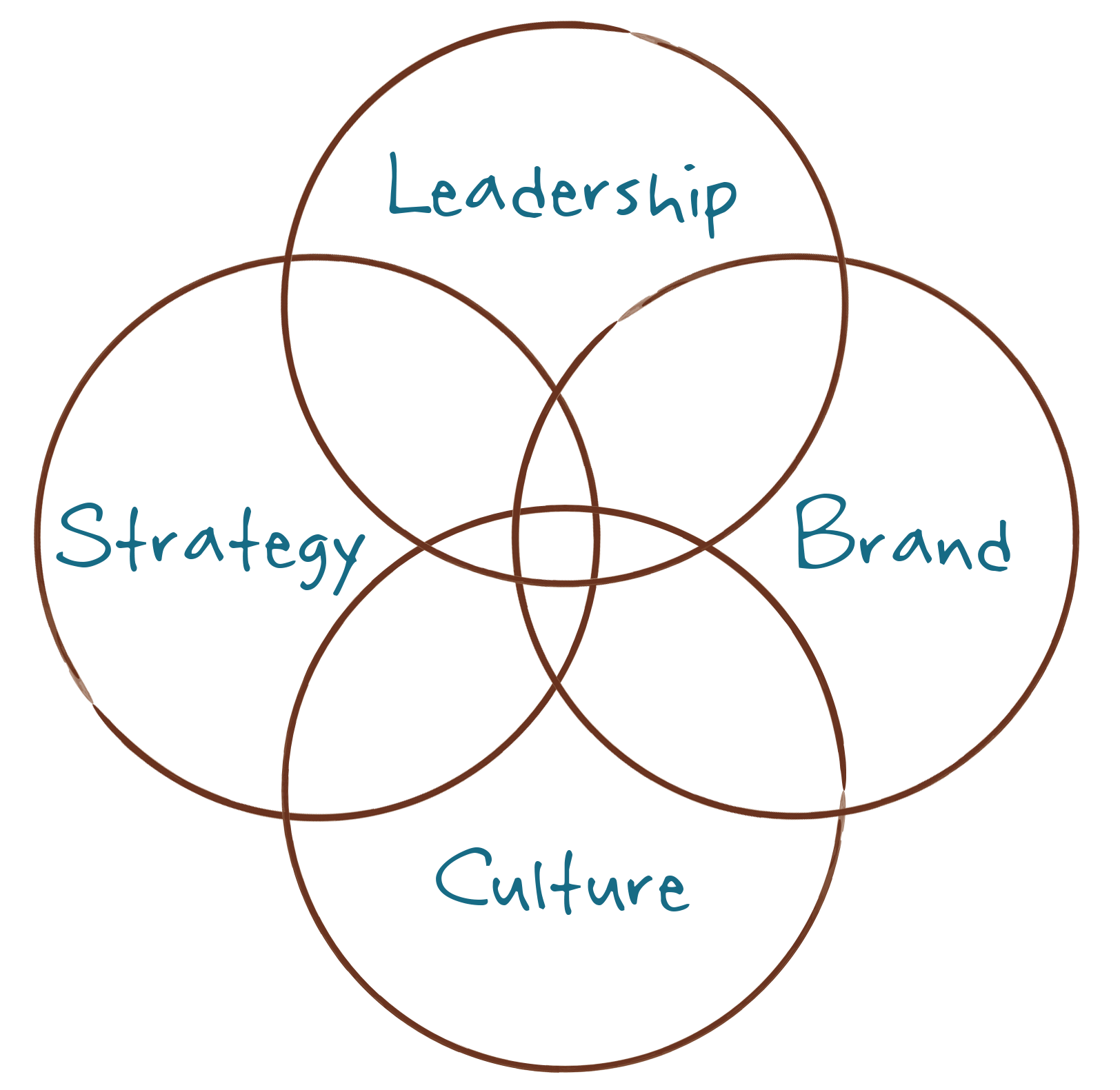Our Approach
Understand Solid Ground’s values, and you’ll know who we are as people. Understand our core principles, and you’ll know how we define effective organizations.
Our approach is illustrated in the big idea we call the Four Dimensions of Sustainable Impact. This model defines the outcome every organization seeks: high impact, sustained over time.
The four dimensions – leadership, strategy, brand, and culture – do not exist in isolation. They overlap, shape, and influence each other. Building strengths in each dimension is akin to building the organization’s core muscles. But the finesse of an organization is found in how well these strengths work interdependently – specifically, how much an organization relies on the other three dimensions when working on any one of them. Good leaders make good decisions in all dimensions. Conversely, a weak culture can undermine the best strategy and brand.
At the very center of this diagram, where all dimensions overlap, is the heart of effective organizational behavior. This is where transformation takes place. This is where investment pays off. Organizations develop finesse by finding, developing, and expanding the overlap of these dimensions.
Strengthening and integrating these four dimensions is the heart of the Solid Ground practice. We build the capacity and confidence of leaders to make a difference in their community, using these four dimensions as the framework to our service.

The Four Dimensions
 Leadership is the beating heart that drives an organization forward. Ultimately, when it comes to making a difference, people don’t follow ideas. They follow people (with good ideas). Among nonprofits, we work with leaders at the board and staff levels. Among public institutions and agencies and other organizations without governing boards, we work with executive leaders and their management teams.
Leadership is the beating heart that drives an organization forward. Ultimately, when it comes to making a difference, people don’t follow ideas. They follow people (with good ideas). Among nonprofits, we work with leaders at the board and staff levels. Among public institutions and agencies and other organizations without governing boards, we work with executive leaders and their management teams.
Leaders on a board of directors bring a deep understanding of the needs of the community to shape and guide direction. They also bring relationships they can help forge in support of the mission. We support boards in fulfilling their governance leadership responsibilities by managing resources, managing relationships, and defining a path to a compelling, essential future.
Our focus with executives (in partnership with their boards or on their own) is building compelling visions and achieving effective, sustainable follow-through. We also help leaders within staff convert ideas to action, turn outputs into outcomes, and convert intention into accomplishment.
Because of its fundamental nature, leadership at its best is developed with patience and great intention, and never left to chance. Our commitment is to help leaders develop the confidence and capability to make the difference they seek.
Our Leadership Services:
- Board / Staff / Team Development
- Executive Search
- Succession Planning
- Coaching
 Strategy, or strategic thinking, is the best known dimension. It is also most overused. The value of strategic thinking is obvious – intention, deliberation, calculation, and coordination all play central roles in effective decision-making. The strategy dimension tends to be called on most in planning. And almost every organization would benefit from better planning (think: inclusive and agile).
Strategy, or strategic thinking, is the best known dimension. It is also most overused. The value of strategic thinking is obvious – intention, deliberation, calculation, and coordination all play central roles in effective decision-making. The strategy dimension tends to be called on most in planning. And almost every organization would benefit from better planning (think: inclusive and agile).
Organizations, however, can jump too quickly to the logic process and stay there, without integrating the other dimensions. Planning is best when it incorporates significant elements of leadership, brand, and especially culture. Done interdependently, it results not only in a plan, but a stronger organization to implement the plan.
In all planning, three steps are required to effective decision-making. We must understand the problem, devise the solution, and implement the plan. These three steps reflect the universal framework for all planning processes.
When complete, a quality plan will answer three questions: where are we going, how will we get there, what will be required to get there. These translate neatly to the three outcomes most desired from planning.
In strategic planning, Solid Ground emphasizes what we call the Strategic Direction. This is the guiding component of the plan, the piece that defines the difference an organization will make in the community or the public more generally. It responds with solutions to problems or gaps discovered in an assessment of stakeholder needs. It provides the “why” for everything the organization does. It is supported by a high-level Program Strategy, which answers “What do our programs deliver over time in service to that direction?” Finally, the detail comes in the Annual Plan and Budget, which specify “What we do this year and how much it will cost.”
Good strategy and committed ownership follows when the stakeholders responsible for executing the plan are fully engaged in its development. Therefore, the planning process (we’re back to culture here) is almost always more important than the final plan documents themselves.
Our Strategy Services:
- Organizational Assessment
- Strategic Planning
- Revenue Development Planning
- Campaign Readiness Assessment and Planning
Among the most strategic decisions an organization can make involves collaboration with other groups. In reality, collaboration is a spectrum of choices, from simple resource sharing to an alliance, joint venture, or merger. When organizations can benefit from working together, we help them explore the spectrum of collaboration, find the place that best serves their missions, goals, and constituent interests, and ensure the right team and human resource policies and practices are in place.
Our Merger/Collaboration Services:
- Facilitation of Full Merger Process
- Due Diligence Management
- Collaboration Assessment/Plan
- Facilitation of Multi-Stakeholder Collaboration
 Our organization’s community – constituents, funders, clients, leaders – cares little about what we do. They care deeply about what difference we make. We’d be wise to remember this when we consider our brand.
Our organization’s community – constituents, funders, clients, leaders – cares little about what we do. They care deeply about what difference we make. We’d be wise to remember this when we consider our brand.
Brand is much more than its visual expression through a logo and color palette. Brand is a promise delivered – the difference you made and others experienced. Conversely, brand can also be a promise not delivered. High-impact organizations know what their communities need them to be and strive to become that.
We spend so much time doing (strategy dimension) that we fail to consider what our organization is becoming. Brand answers key questions of organizational identity and positioning: Who are you? How are you different (from organizations like you)? What do you stand for? Why do you matter (to me)?
These are not just concerns for marketing and communications (where branding typically resides). They are at the heart of core strategic decisions, right next to vision and mission. They are questions for leadership. They are deeply intertwined with culture. And their answers correspond to your positioning strategy for competitive advantage and a compelling value proposition.
We help organizations comprehensively assess and develop their brands. At other times we zero in on positioning issues that emerge in strategic planning: how you can best respond to community need in ways that are distinct and valued. Always we consider brand in the context of leadership, strategy, and culture. And we’ll identify effective approaches to communicating your brand externally and delivering on your promise internally.
Our Brand Services:
-
Brand Assessment
-
Brand Platform Development
-
Communications Planning
-
Fundraising Case Development
 Famous management consultant Peter Drucker said, “Culture eats strategy for breakfast.” But everyone who has ever been part of any group or organization knows this simple truth. Culture has a powerful influence over every other aspect of any organization, though sometimes it isn’t visible. Our objective is to bring it more into view for our clients.
Famous management consultant Peter Drucker said, “Culture eats strategy for breakfast.” But everyone who has ever been part of any group or organization knows this simple truth. Culture has a powerful influence over every other aspect of any organization, though sometimes it isn’t visible. Our objective is to bring it more into view for our clients.
Every organization has culture. Culture takes on many faces and forms. Integrity in the moment of choice. A culture of appreciation. Healthy, constructive tension. Positive feedback and accountability. A base of strong interpersonal relationships. Organizations either get the culture they get, or they get the culture they want. The difference is the crucial ingredient of intention. Helping groups establish their intention is a central piece of our work together.
Heightened awareness, social unrest, and elementary changes emerged from tragedy after tragedy during the pandemic and before. More people see their part of the problem and their responsibility in the change. More conversations are happening. More are needed.
The best intentions are only as strong as the behaviors that support them. How a group chooses to behave – its intended culture – will have great influence over how individuals respond and participate. And how a group includes others – its core values around equity and inclusion – sets the foundation for nearly every other value.
Healthy culture recognizes that many of our organizations reflect the dark history of disenfranchisement in our country. Racism, sexism, and other forms of oppression have been baked into our country’s institutions and culture – and by extension into virtually every public and private organization to one degree or another. Only when we see and confront these injustices outside and inside our organizations do we pave the way for the culture we want. We share this journey with our clients.
Our Culture Services:
- Equity Assessment and Action Planning
- Culture Compacts
- Team Building
- Coaching

